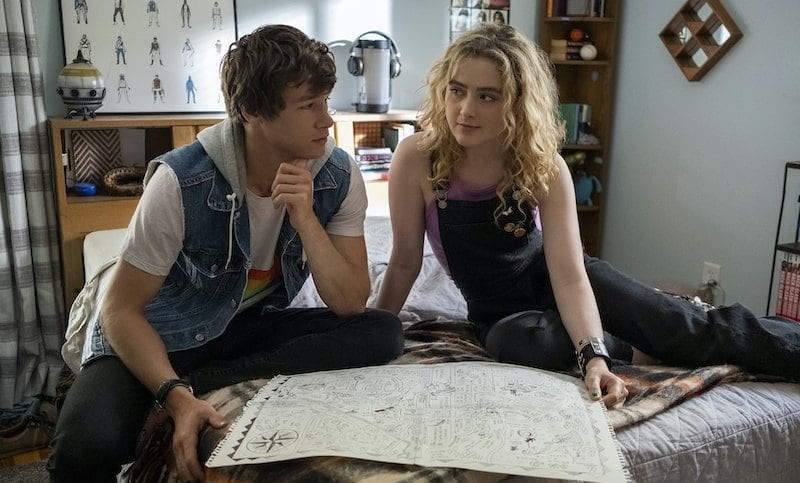Reviewed by Jeffrey Sanzel
The premise of a time loop has long been a staple of science fiction novels and movies. The most notable example is the 1993 fantasy Groundhog Day, in which a narcissistic television reporter (Bill Murray) is trapped in Punxsutawney, Pennsylvania, where he repeats February 2. Rightfully, it has become a classic comedy, relying on Murray’s performance of edge-to-awakening and a first-rate script by director Harold Ramis, collaborating with Danny Rubin.
Based on the Japanese novel All You Need Is Kill, the less memorable Edge of Tomorrow (2014; marketed appropriately as Live Die Repeat: Edge of Tomorrow on home media) utilized a similar structure. Here, Tom Cruise is a military officer learning how to defeat alien invaders.
Both Groundhog Day and Edge of Tomorrow are referenced in The Map of Tiny Perfect Things, a light comedy-drama, with Lev Grossman’s screenplay, based on his well-crafted short story.
The film follows high school senior Mark (Kyle Allen) already well into his live-repeat of a summer day in Lexington, Massachusetts. His day follows the same sequence of waking up just after his mother pulls away from the house and continues with his interaction with his sister (Cleo Fraser) and slightly lost father (Josh Hamilton).
The breakfast scene shows Mark anticipating everything from the popping of the toaster to speaking simultaneously with his sister as she snidely calls him a loser to his knowing all of the answers to his father’s crossword puzzle. Mark then wanders the town, slightly shifting a range of moments in the world but not growing much from his experiences. His isolation has the feel of the last man on earth. No matter what he tries, every day resets at midnight, as if he is snatched by “some cosmic nanny.”
Mark’s universe shifts with the introduction of Margaret (Kathryn Newton), whom he encounters at the local pool. Quickly, she admits to being locked in the same pattern. What ensues is his pursuit of this mystery figure and their burgeoning friendship. Beginning with Margaret sharing with him an eagle swooping over a lake and capturing a fish, they embark on a quest to search out “tiny perfect” moments. The map they create of these events becomes pivotal in the resolution.
Once they commit to the undertaking, there is a montage — a perfectly executed ride by a skate rat; angel wings on a truck lining up perfectly with a man sitting on a bench; an older woman’s victory dance after a perfect hand of cards; a girl creating an enormous soap bubble; a traffic stop to allow a turtle to cross the road; a cloud in the shape of a question mark. While this is happening, Margaret takes the odd phone call and rushes off without an explanation.
They have a date “on the moon,” which culminates with a bicycle ride through the school hallways. (The score indicates much of the film’s emotion, either smart or a cheat, depending on which way you look at it.) The closer they become, the more she pulls away. This conflict is the heart of the story, which resolves near the end.
Tension rises between them as he falls for her. In turn, he wants their odd existence to mean something. She is inexplicably hesitant and pulls away. With this, he accepts that his problem is a lack of awareness of the struggle of the people around him; his downward spiral into loneliness sets him on a new and more positive course.
The film finds standard but entertaining ways to harness the gimmick. They give away money to random strangers. They stuff themselves with ice cream and junk food. A wonderful sequence is the near misses involving a beach ball and a girl at the pool. Another running joke shows Mark stopping a man (cameo by author Grossman) from being the victim of bird droppings.
A major change from the short story’s first-person narrative is the introduction of Mark’s sidekick, the video game playing Henry (Jermaine Harris). As there is no voiceover, this gives Mark a chance to public his thoughts. While a facile solution, it works because of Harris’s command of Henry’s understated patter and dubious puzzlement over Mark’s strange musings. Henry being locked on the same level of the alien-themed video game adds another layer (and a nod towards Edge of Tomorrow and the overall thematic metaphor) to the story.
For the most part, the film is a two-hander, relying on the charm of its leads. Allen has a bland, all-American charm that works for Mark. His realizations are believable, and his shift from passive to active drives the last third of the film. Newton manages not to overplay Margaret’s quirkiness. She is off-beat but grounded, with a playful veneer masking the pain underneath. She makes a line like “I’ll call you tomorrow … today … tomorrow,” both humorous and melancholy. They have good chemistry, which makes them sharing this existential problem convincing and saves the growing romance from becoming saccharine.
The Map of Tiny Perfect Things is a sweet if predictable diversion. The idea of fixing what we can and accepting what we cannot is certainly not an original concept. Nor is the idea that growth comes from facing challenges. But in its telling, the film is a pleasant if obvious look at how we move forward.
Rated PG-13, The Map of Tiny Perfect Things is now streaming on Amazon Prime.







